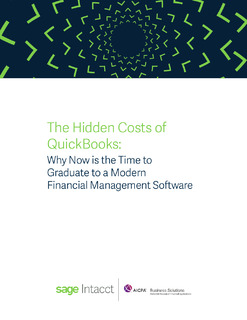Most small businesses begin their financial lives using Intuit’s QuickBooks, which—with more than
80% market share—is by far the best and most popular small business accounting application. It’s well
known. It’s easy. It works, and it offers the functionality a business needs when it’s starting out.
But if your business has moved beyond the entry level, your organization may be facing a number of
challenges as you hit the limits of QuickBooks’ functionality. QuickBooks simply wasn’t designed to
provide professional financial management capabilities to growing organizations with sophisticated,
evolving demands that require more and better visibility into financial and operational performance—
such as automating key processes, providing anytime, anywhere access, enforcing internal controls,
customizing functionality, and integrating with other critical applications.
How do you know when it’s the right time make the move? Which options should you consider? What are
the hidden costs of waiting? How can you measure the costs against the benefits?
This paper outlines a framework to help your organization assess the hidden costs of continuing to
use QuickBooks along with the financial upside of switching to a modern financial management and
accounting system, and will help you:
- Decide the best time to switch from QuickBooks to a more robust, cloud computing-based system
- Identify the hidden costs of continuing to use QuickBooks
- Evaluate the available alternatives, a solution that will grow with your business needs
- Compare the cost of the status quo with the benefits of switching


